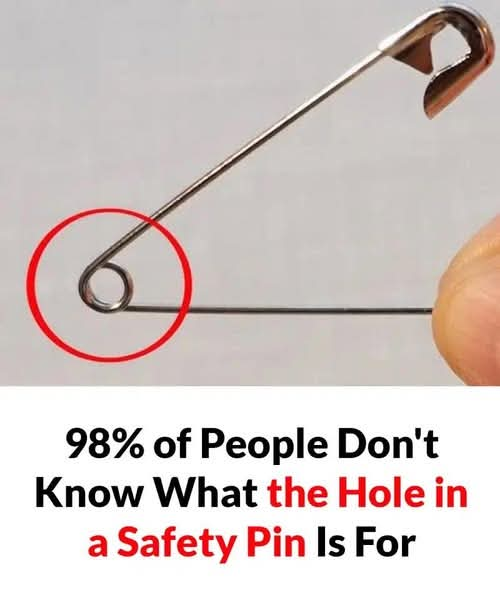What’s the Purpose of That Tiny Hole in a Safety Pin? You’ve Probably Never Noticed, But It’s Brilliant
You’ve used them. Clipped them. Trusted them to hold things together in moments of wardrobe chaos or crafty improvisation.
The safety pin: humble, overlooked, yet always reliable.
Unlocking the Hidden Genius Behind Everyday Items – You’ll Never Look at a Safety Pin the Same Way Again!
Tiny Hole in a Safety Pin

But have you ever looked closely—really closely—at a safety pin?
Tucked near the spring mechanism, there’s often a tiny little hole. No bigger than the head of a pin (pun intended). It’s so subtle, so quiet, that most people never even notice it.
But here’s the kicker:
It’s more than simply adornment. This is not a mistake. It’s a mini-design masterpiece.
Let us discover the hidden genius underlying that barely-there feature.

That Tiny Hole Is the Unsung Hero of Safety Pins
In the world of design, form always comes after function—and this tiny hole is no exception.
The hole is near the spring coil of the safety pin. While it may appear tiny, its purpose is inextricably linked to the safety pin’s renowned snap-and-lock mechanism.
The hole is there for one key reason:
It allows the pin to be manufactured, assembled, and coiled correctly without losing its structural tension.
Let’s break it down:
During manufacture, a machine coils the wire to create the coil. This little hole serves as an anchor or guide point during the operation. It helps to maintain the proper angle and tension, allowing the pin to open and close smoothly but not too easily. Is that gentle resistance? You may thank that tiny hole.
It ensures:
- Proper spring tension.
- A secure snap-in-place effect.
- Durability after multiple applications
In a nutshell, it’s a microscopic ingredient with macroscopic consequences.
It’s Engineering Elegance — Hiding in Plain Sight
This minor design feature has a delightfully human quality.
We employ safety pins in a variety of settings, including crises, creativity, parenting, art, punk fashion, and medical. They’ve stored newborn nappies, race bibs, sari pleats, and even wedding gowns.
Despite our reliance on this instrument, it holds a secret. This is modest, quiet brilliance.

No logo. No flash. Simply fine engineering blending into the backdrop of daily existence.
That tiny hole serves as a reminder that even the smallest things are designed with intention. That design does not need to yell to be effective. And that function can sometimes appear to be simple.
The Next Time You Hold a Safety Pin…
Take a second. Feel the strain as you open it. Hear the slight crack as it clicks shut.
Now look down at the little hole.
You’ll know a secret that most people don’t. You will notice the genius hidden beneath the mundane.
And maybe—just maybe—you’ll understand how even life’s simplest instruments hold tales, purpose, and the silent legacy of bright minds who believed in doing small things well.


Timeless Sewing Tricks Worth Bringing Back Modern machines make sewing faster, but old-school techniques offer surprising advantages—like this forgotten gem:
The Secret Weapon? Beeswax. Glide your thread across beeswax before sewing. It strengthens the thread, prevents tangles, and leads to smoother, cleaner stitches.

1.Mark with Dry Soap – No chalk?
A sliver of dry soap marks fabric clearly and washes right out.
2.Backstitch for Strength – Secure seams by stitching backward over the last few centimeters—easy reinforcement that prevents unraveling.
3. Pin Diagonally – Angled pins,
When it comes to everyday objects, the safety pin is one of the most underrated heroes. It’s been holding things together—literally—for over a century. But have you ever noticed that tiny hole near the clasp? Most people haven’t. And even if they have, 98% have no idea what it’s actually for.
Let’s change that today.
🔍 Why Is There a Tiny Hole in a Safety Pin?
At first glance, it might seem like a random manufacturing quirk, but that tiny hole has a purpose rooted in precision, safety, and design efficiency.
✅ 1. Mechanical Balance:
The hole helps distribute the tension evenly when the pin is closed, especially during mass production. It ensures that the clasp locks more securely and maintains its form over time.
✅ 2. Manufacturing Alignment:
During the automated production process, that hole serves as a reference point or anchor. It helps machines align, bend, and close the pin consistently at high speed.
✅ 3. Safety Enhancement:
It acts as a pressure release point. If excessive force is applied, the hole helps prevent the pin from snapping dangerously, reducing the risk of accidental injury.

💡 Why You’ve Probably Never Heard This Before
Despite the fact that billions of safety pins are used globally, this small but vital detail is almost never talked about. That’s because we tend to focus on how things work, not why they’re designed the way they are.
This little hole is a reminder that everyday objects are often engineered with hidden brilliance—and when you know about it, you appreciate them more.
✨ Final Thoughts: The Hidden Genius in Everyday Life
It’s easy to overlook the small things. But sometimes, it’s the tiniest details—like a simple hole in a safety pin—that hold the biggest secrets. The next time you use one, take a second to admire the thought and intelligence that went into its design.

📌 Who knew a tiny hole could be so important? Now you do—and you’re part of the 2% who actually get it!





